Market Structure and Entry Strategy
VerifiedAdded on 2021/04/17
|11
|2064
|283
AI Summary
This assignment requires research teams to identify the market structure of the energy bar industry. They must analyze the number of existing competitors, customer base, type of products, rival strategies, and concentration ratio to determine if it's a competitive, monopolistically competitive, or oligopoly market. With this information, they can develop an effective entry strategy for Schmeckt Gut's Besser energy bars.
Contribute Materials
Your contribution can guide someone’s learning journey. Share your
documents today.
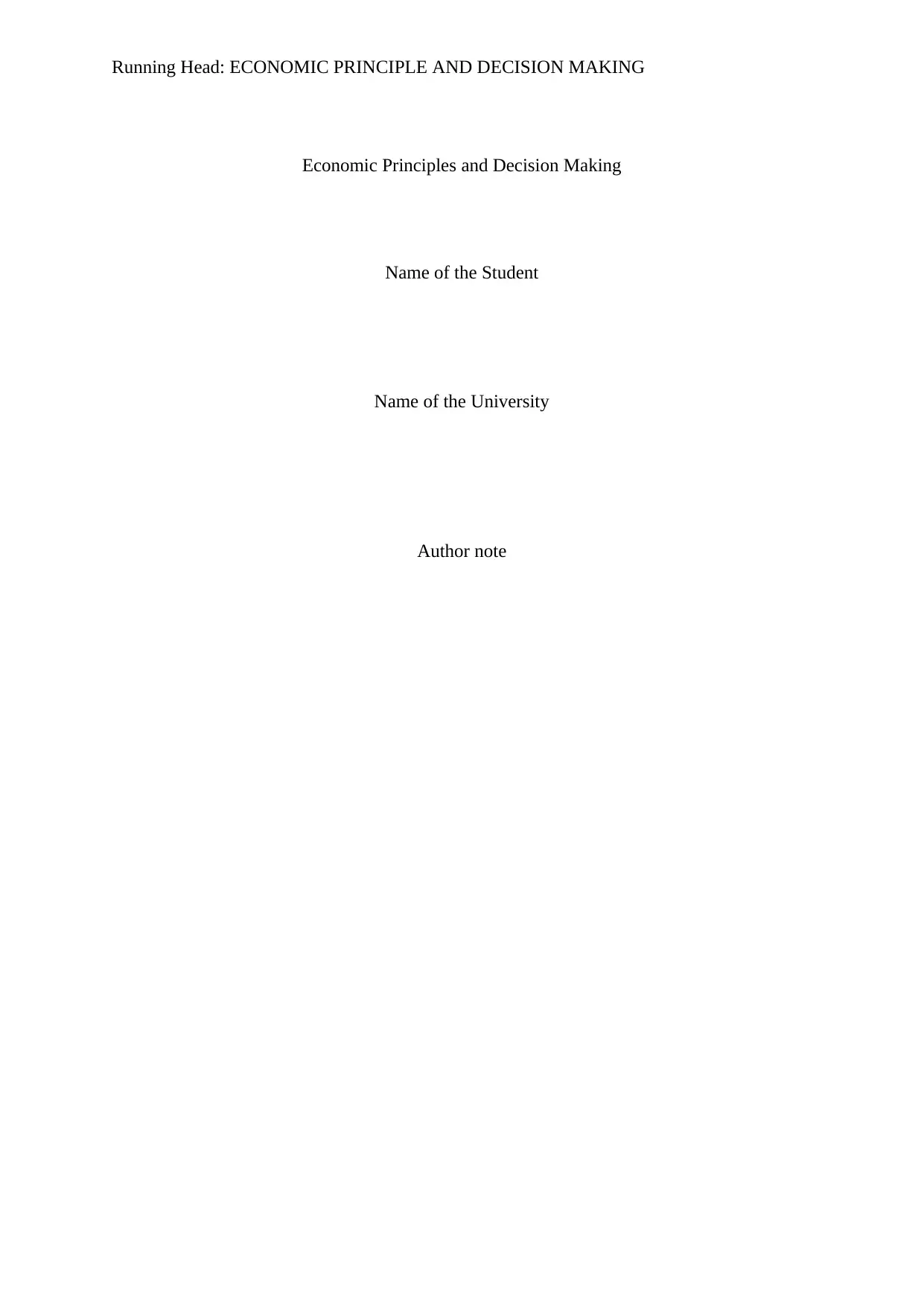
Running Head: ECONOMIC PRINCIPLE AND DECISION MAKING
Economic Principles and Decision Making
Name of the Student
Name of the University
Author note
Economic Principles and Decision Making
Name of the Student
Name of the University
Author note
Secure Best Marks with AI Grader
Need help grading? Try our AI Grader for instant feedback on your assignments.
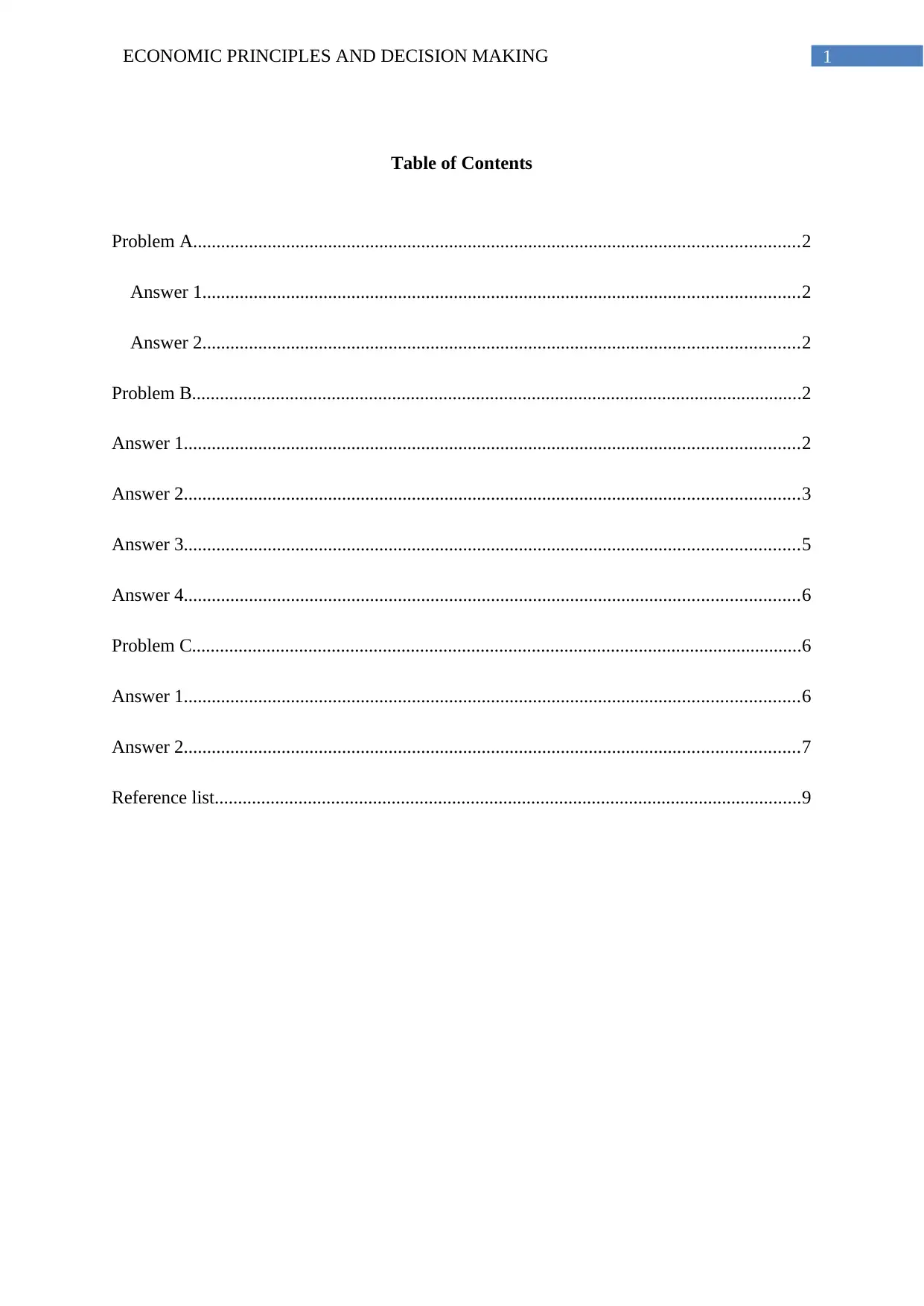
1ECONOMIC PRINCIPLES AND DECISION MAKING
Table of Contents
Problem A..................................................................................................................................2
Answer 1................................................................................................................................2
Answer 2................................................................................................................................2
Problem B...................................................................................................................................2
Answer 1....................................................................................................................................2
Answer 2....................................................................................................................................3
Answer 3....................................................................................................................................5
Answer 4....................................................................................................................................6
Problem C...................................................................................................................................6
Answer 1....................................................................................................................................6
Answer 2....................................................................................................................................7
Reference list..............................................................................................................................9
Table of Contents
Problem A..................................................................................................................................2
Answer 1................................................................................................................................2
Answer 2................................................................................................................................2
Problem B...................................................................................................................................2
Answer 1....................................................................................................................................2
Answer 2....................................................................................................................................3
Answer 3....................................................................................................................................5
Answer 4....................................................................................................................................6
Problem C...................................................................................................................................6
Answer 1....................................................................................................................................6
Answer 2....................................................................................................................................7
Reference list..............................................................................................................................9
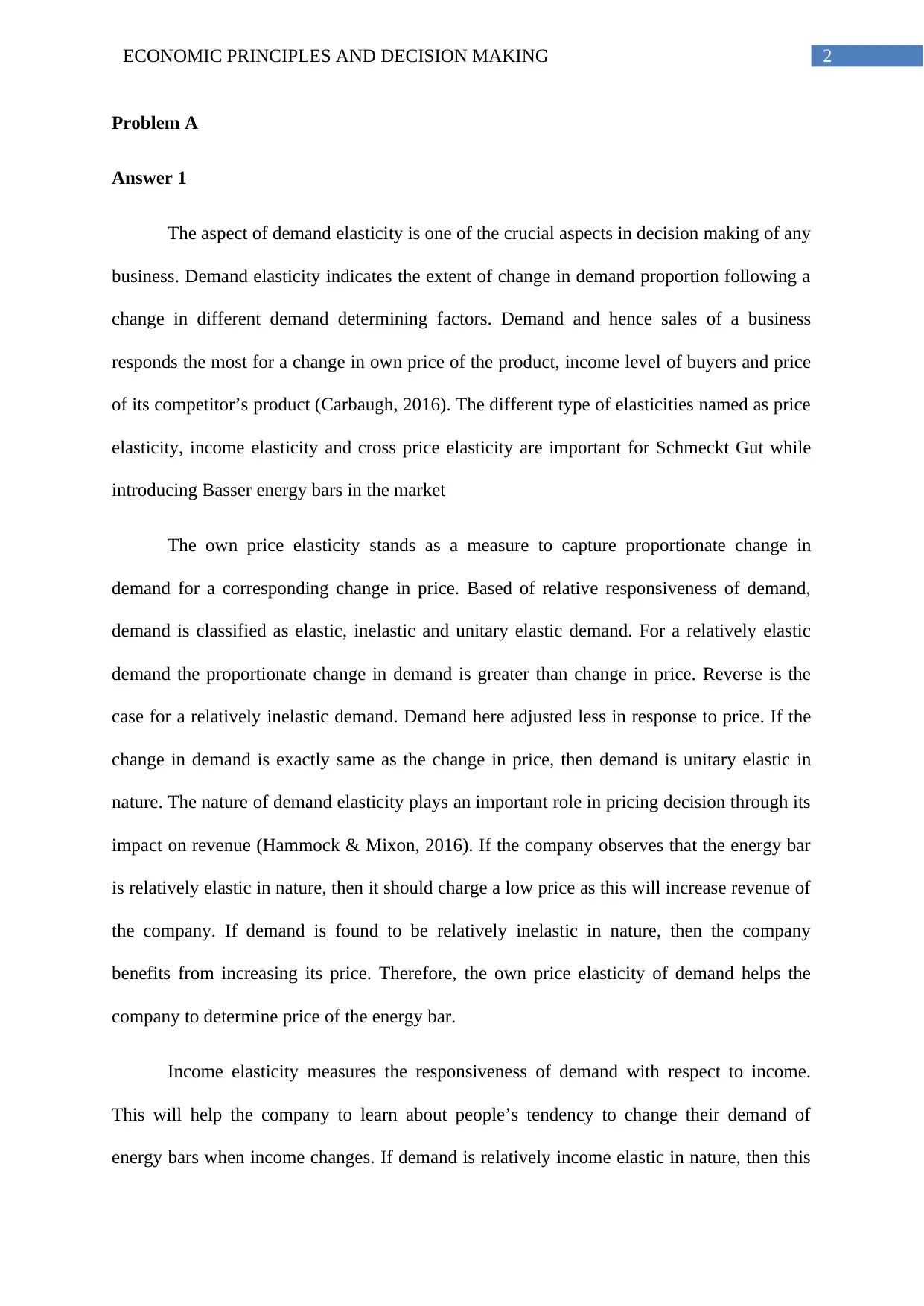
2ECONOMIC PRINCIPLES AND DECISION MAKING
Problem A
Answer 1
The aspect of demand elasticity is one of the crucial aspects in decision making of any
business. Demand elasticity indicates the extent of change in demand proportion following a
change in different demand determining factors. Demand and hence sales of a business
responds the most for a change in own price of the product, income level of buyers and price
of its competitor’s product (Carbaugh, 2016). The different type of elasticities named as price
elasticity, income elasticity and cross price elasticity are important for Schmeckt Gut while
introducing Basser energy bars in the market
The own price elasticity stands as a measure to capture proportionate change in
demand for a corresponding change in price. Based of relative responsiveness of demand,
demand is classified as elastic, inelastic and unitary elastic demand. For a relatively elastic
demand the proportionate change in demand is greater than change in price. Reverse is the
case for a relatively inelastic demand. Demand here adjusted less in response to price. If the
change in demand is exactly same as the change in price, then demand is unitary elastic in
nature. The nature of demand elasticity plays an important role in pricing decision through its
impact on revenue (Hammock & Mixon, 2016). If the company observes that the energy bar
is relatively elastic in nature, then it should charge a low price as this will increase revenue of
the company. If demand is found to be relatively inelastic in nature, then the company
benefits from increasing its price. Therefore, the own price elasticity of demand helps the
company to determine price of the energy bar.
Income elasticity measures the responsiveness of demand with respect to income.
This will help the company to learn about people’s tendency to change their demand of
energy bars when income changes. If demand is relatively income elastic in nature, then this
Problem A
Answer 1
The aspect of demand elasticity is one of the crucial aspects in decision making of any
business. Demand elasticity indicates the extent of change in demand proportion following a
change in different demand determining factors. Demand and hence sales of a business
responds the most for a change in own price of the product, income level of buyers and price
of its competitor’s product (Carbaugh, 2016). The different type of elasticities named as price
elasticity, income elasticity and cross price elasticity are important for Schmeckt Gut while
introducing Basser energy bars in the market
The own price elasticity stands as a measure to capture proportionate change in
demand for a corresponding change in price. Based of relative responsiveness of demand,
demand is classified as elastic, inelastic and unitary elastic demand. For a relatively elastic
demand the proportionate change in demand is greater than change in price. Reverse is the
case for a relatively inelastic demand. Demand here adjusted less in response to price. If the
change in demand is exactly same as the change in price, then demand is unitary elastic in
nature. The nature of demand elasticity plays an important role in pricing decision through its
impact on revenue (Hammock & Mixon, 2016). If the company observes that the energy bar
is relatively elastic in nature, then it should charge a low price as this will increase revenue of
the company. If demand is found to be relatively inelastic in nature, then the company
benefits from increasing its price. Therefore, the own price elasticity of demand helps the
company to determine price of the energy bar.
Income elasticity measures the responsiveness of demand with respect to income.
This will help the company to learn about people’s tendency to change their demand of
energy bars when income changes. If demand is relatively income elastic in nature, then this
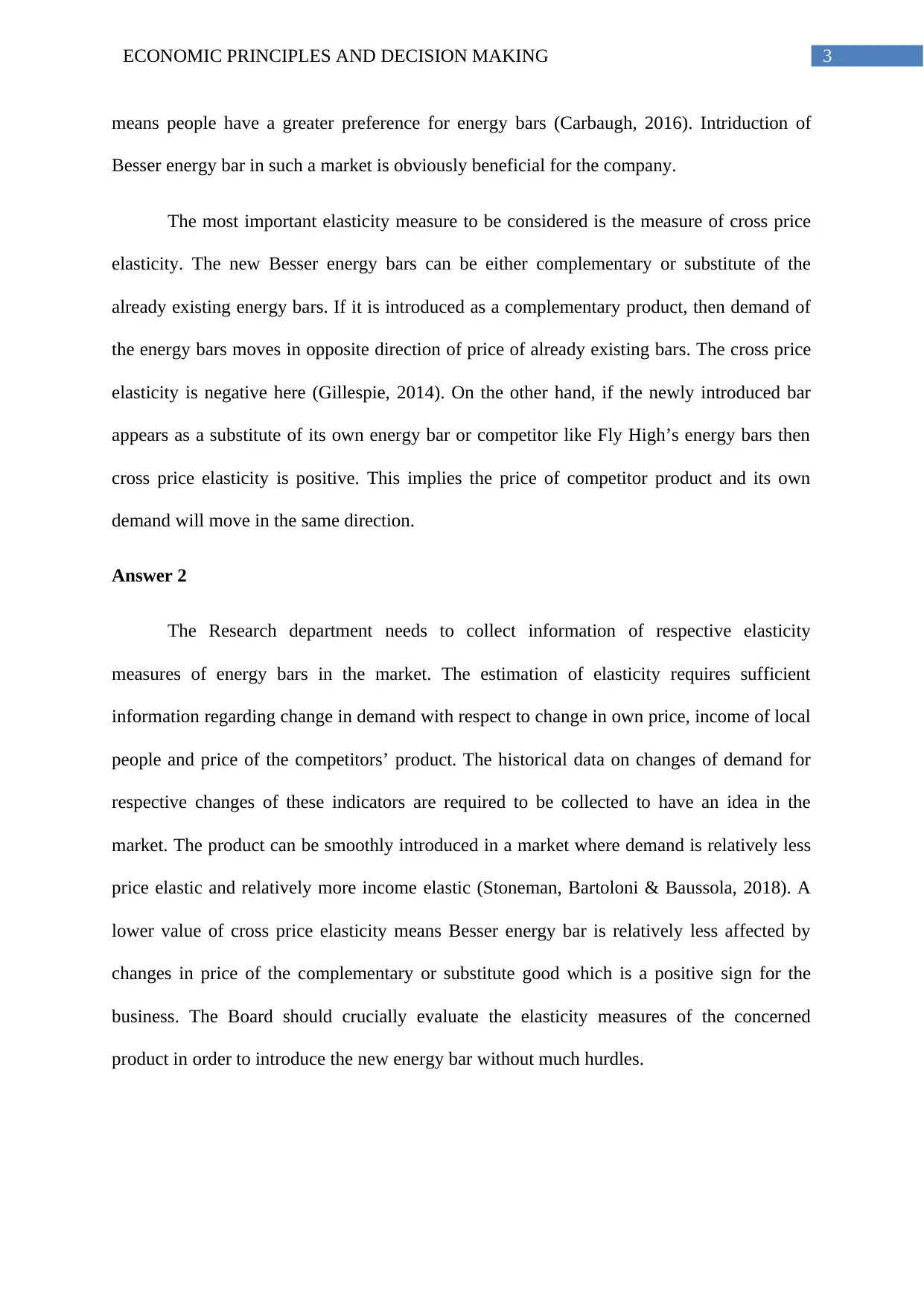
3ECONOMIC PRINCIPLES AND DECISION MAKING
means people have a greater preference for energy bars (Carbaugh, 2016). Intriduction of
Besser energy bar in such a market is obviously beneficial for the company.
The most important elasticity measure to be considered is the measure of cross price
elasticity. The new Besser energy bars can be either complementary or substitute of the
already existing energy bars. If it is introduced as a complementary product, then demand of
the energy bars moves in opposite direction of price of already existing bars. The cross price
elasticity is negative here (Gillespie, 2014). On the other hand, if the newly introduced bar
appears as a substitute of its own energy bar or competitor like Fly High’s energy bars then
cross price elasticity is positive. This implies the price of competitor product and its own
demand will move in the same direction.
Answer 2
The Research department needs to collect information of respective elasticity
measures of energy bars in the market. The estimation of elasticity requires sufficient
information regarding change in demand with respect to change in own price, income of local
people and price of the competitors’ product. The historical data on changes of demand for
respective changes of these indicators are required to be collected to have an idea in the
market. The product can be smoothly introduced in a market where demand is relatively less
price elastic and relatively more income elastic (Stoneman, Bartoloni & Baussola, 2018). A
lower value of cross price elasticity means Besser energy bar is relatively less affected by
changes in price of the complementary or substitute good which is a positive sign for the
business. The Board should crucially evaluate the elasticity measures of the concerned
product in order to introduce the new energy bar without much hurdles.
means people have a greater preference for energy bars (Carbaugh, 2016). Intriduction of
Besser energy bar in such a market is obviously beneficial for the company.
The most important elasticity measure to be considered is the measure of cross price
elasticity. The new Besser energy bars can be either complementary or substitute of the
already existing energy bars. If it is introduced as a complementary product, then demand of
the energy bars moves in opposite direction of price of already existing bars. The cross price
elasticity is negative here (Gillespie, 2014). On the other hand, if the newly introduced bar
appears as a substitute of its own energy bar or competitor like Fly High’s energy bars then
cross price elasticity is positive. This implies the price of competitor product and its own
demand will move in the same direction.
Answer 2
The Research department needs to collect information of respective elasticity
measures of energy bars in the market. The estimation of elasticity requires sufficient
information regarding change in demand with respect to change in own price, income of local
people and price of the competitors’ product. The historical data on changes of demand for
respective changes of these indicators are required to be collected to have an idea in the
market. The product can be smoothly introduced in a market where demand is relatively less
price elastic and relatively more income elastic (Stoneman, Bartoloni & Baussola, 2018). A
lower value of cross price elasticity means Besser energy bar is relatively less affected by
changes in price of the complementary or substitute good which is a positive sign for the
business. The Board should crucially evaluate the elasticity measures of the concerned
product in order to introduce the new energy bar without much hurdles.
Secure Best Marks with AI Grader
Need help grading? Try our AI Grader for instant feedback on your assignments.
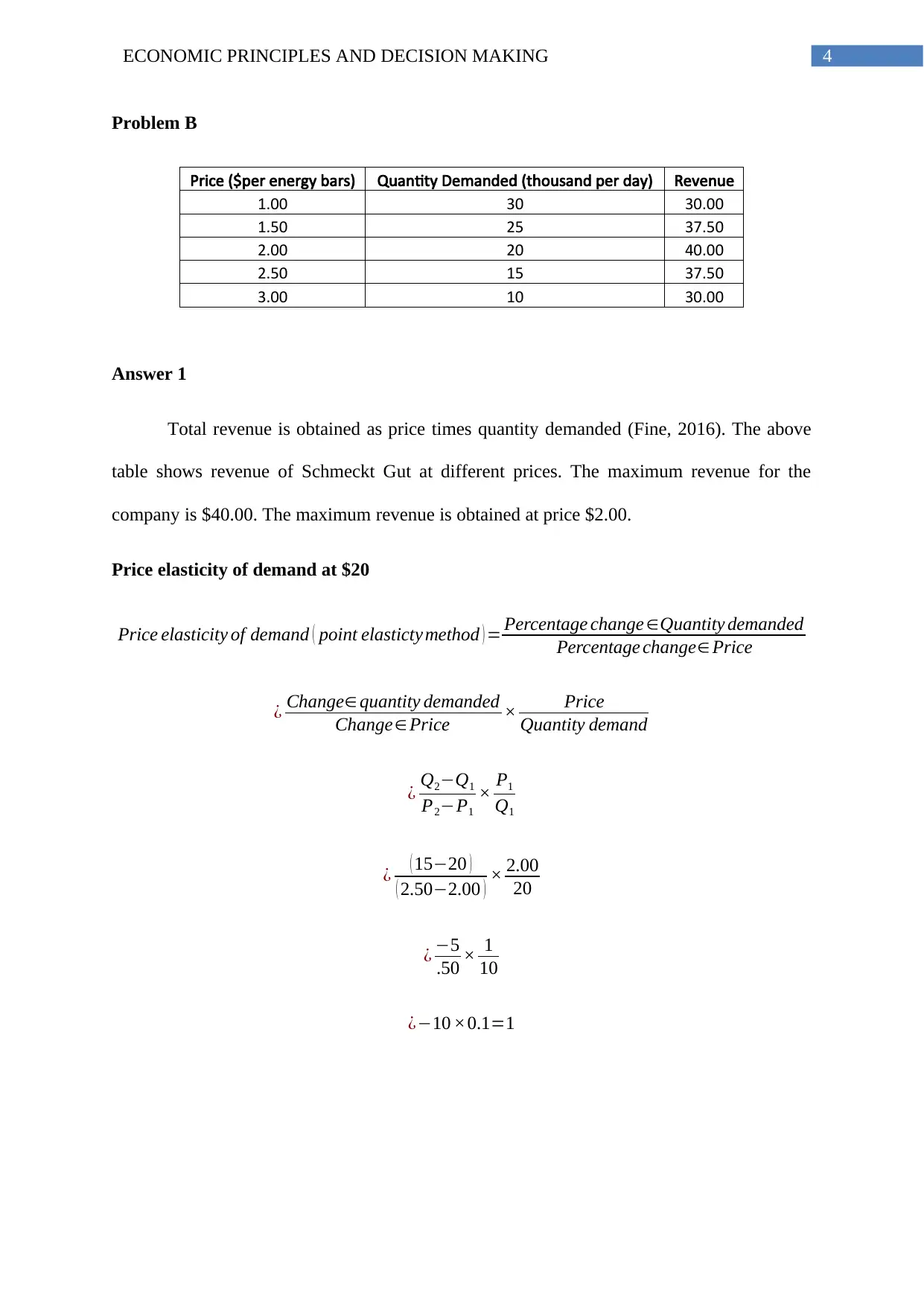
4ECONOMIC PRINCIPLES AND DECISION MAKING
Problem B
Price ($per energy bars) Quantity Demanded (thousand per day) Revenue
1.00 30 30.00
1.50 25 37.50
2.00 20 40.00
2.50 15 37.50
3.00 10 30.00
Answer 1
Total revenue is obtained as price times quantity demanded (Fine, 2016). The above
table shows revenue of Schmeckt Gut at different prices. The maximum revenue for the
company is $40.00. The maximum revenue is obtained at price $2.00.
Price elasticity of demand at $20
Price elasticity of demand ( point elasticty method ) = Percentage change ∈Quantity demanded
Percentage change∈ Price
¿ Change∈ quantity demanded
Change∈Price × Price
Quantity demand
¿ Q2−Q1
P2−P1
× P1
Q1
¿ ( 15−20 )
( 2.50−2.00 ) × 2.00
20
¿ −5
.50 × 1
10
¿−10 ×0.1=1
Problem B
Price ($per energy bars) Quantity Demanded (thousand per day) Revenue
1.00 30 30.00
1.50 25 37.50
2.00 20 40.00
2.50 15 37.50
3.00 10 30.00
Answer 1
Total revenue is obtained as price times quantity demanded (Fine, 2016). The above
table shows revenue of Schmeckt Gut at different prices. The maximum revenue for the
company is $40.00. The maximum revenue is obtained at price $2.00.
Price elasticity of demand at $20
Price elasticity of demand ( point elasticty method ) = Percentage change ∈Quantity demanded
Percentage change∈ Price
¿ Change∈ quantity demanded
Change∈Price × Price
Quantity demand
¿ Q2−Q1
P2−P1
× P1
Q1
¿ ( 15−20 )
( 2.50−2.00 ) × 2.00
20
¿ −5
.50 × 1
10
¿−10 ×0.1=1
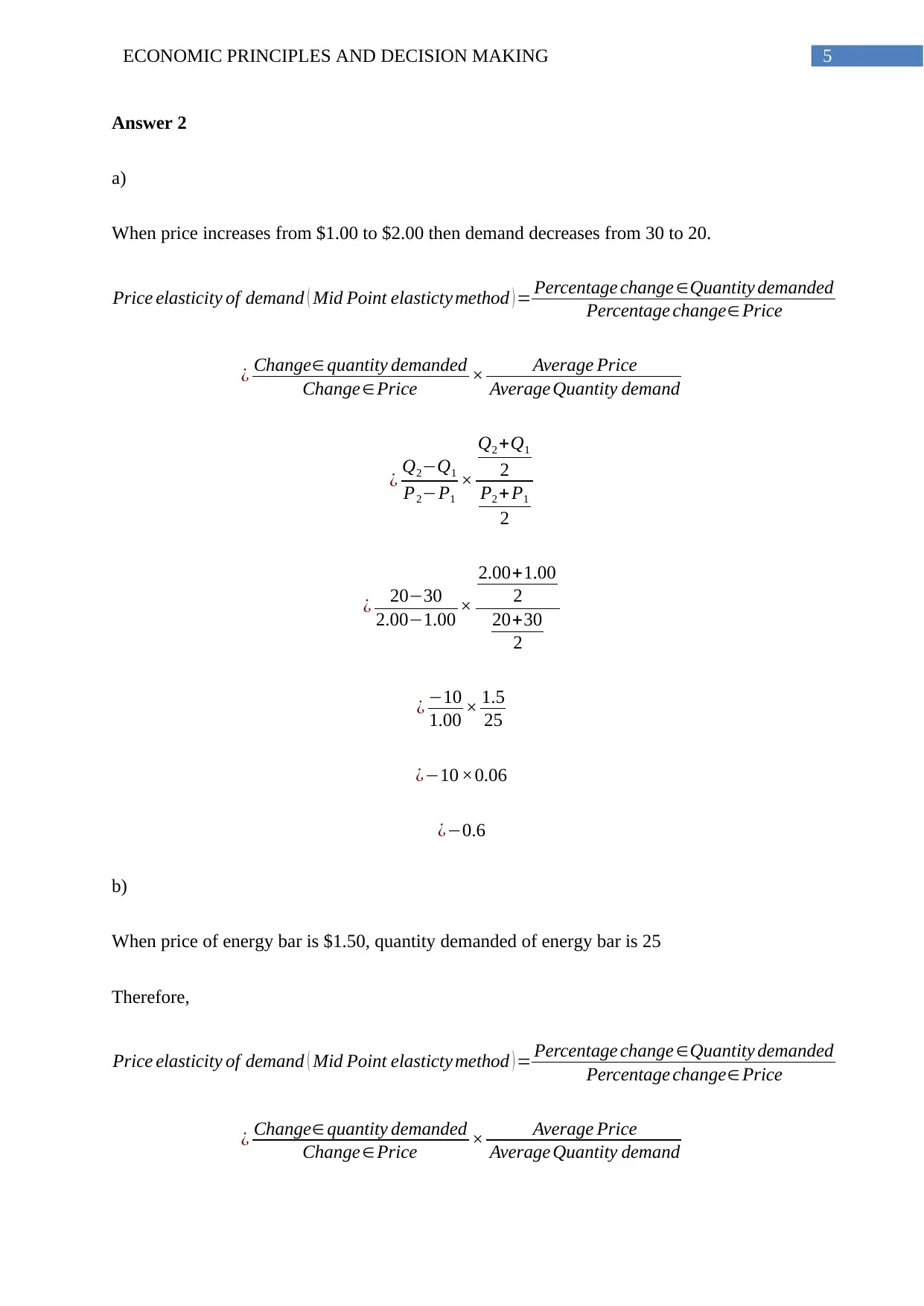
5ECONOMIC PRINCIPLES AND DECISION MAKING
Answer 2
a)
When price increases from $1.00 to $2.00 then demand decreases from 30 to 20.
Price elasticity of demand ( Mid Point elasticty method ) = Percentage change ∈Quantity demanded
Percentage change∈ Price
¿ Change∈ quantity demanded
Change∈Price × Average Price
Average Quantity demand
¿ Q2−Q1
P2−P1
×
Q2 +Q1
2
P2 + P1
2
¿ 20−30
2.00−1.00 ×
2.00+1.00
2
20+30
2
¿ −10
1.00 × 1.5
25
¿−10 ×0.06
¿−0.6
b)
When price of energy bar is $1.50, quantity demanded of energy bar is 25
Therefore,
Price elasticity of demand ( Mid Point elasticty method ) = Percentage change ∈Quantity demanded
Percentage change∈ Price
¿ Change∈ quantity demanded
Change∈Price × Average Price
Average Quantity demand
Answer 2
a)
When price increases from $1.00 to $2.00 then demand decreases from 30 to 20.
Price elasticity of demand ( Mid Point elasticty method ) = Percentage change ∈Quantity demanded
Percentage change∈ Price
¿ Change∈ quantity demanded
Change∈Price × Average Price
Average Quantity demand
¿ Q2−Q1
P2−P1
×
Q2 +Q1
2
P2 + P1
2
¿ 20−30
2.00−1.00 ×
2.00+1.00
2
20+30
2
¿ −10
1.00 × 1.5
25
¿−10 ×0.06
¿−0.6
b)
When price of energy bar is $1.50, quantity demanded of energy bar is 25
Therefore,
Price elasticity of demand ( Mid Point elasticty method ) = Percentage change ∈Quantity demanded
Percentage change∈ Price
¿ Change∈ quantity demanded
Change∈Price × Average Price
Average Quantity demand
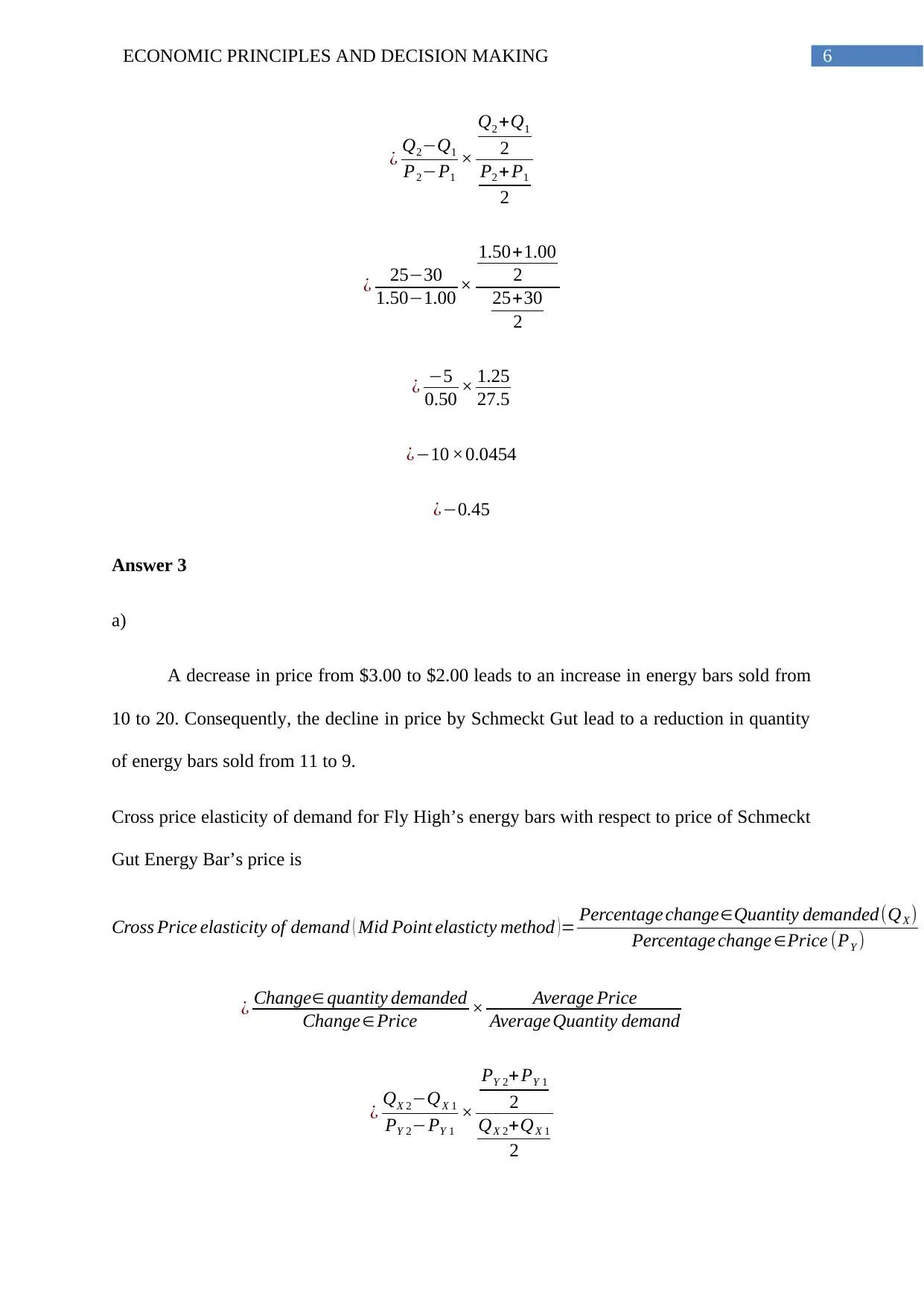
6ECONOMIC PRINCIPLES AND DECISION MAKING
¿ Q2−Q1
P2−P1
×
Q2 +Q1
2
P2 + P1
2
¿ 25−30
1.50−1.00 ×
1.50+1.00
2
25+30
2
¿ −5
0.50 × 1.25
27.5
¿−10 ×0.0454
¿−0.45
Answer 3
a)
A decrease in price from $3.00 to $2.00 leads to an increase in energy bars sold from
10 to 20. Consequently, the decline in price by Schmeckt Gut lead to a reduction in quantity
of energy bars sold from 11 to 9.
Cross price elasticity of demand for Fly High’s energy bars with respect to price of Schmeckt
Gut Energy Bar’s price is
Cross Price elasticity of demand ( Mid Point elasticty method )= Percentage change∈Quantity demanded(QX )
Percentage change ∈Price (PY )
¿ Change∈ quantity demanded
Change∈Price × Average Price
Average Quantity demand
¿ QX 2−QX 1
PY 2−PY 1
×
PY 2+PY 1
2
QX 2+QX 1
2
¿ Q2−Q1
P2−P1
×
Q2 +Q1
2
P2 + P1
2
¿ 25−30
1.50−1.00 ×
1.50+1.00
2
25+30
2
¿ −5
0.50 × 1.25
27.5
¿−10 ×0.0454
¿−0.45
Answer 3
a)
A decrease in price from $3.00 to $2.00 leads to an increase in energy bars sold from
10 to 20. Consequently, the decline in price by Schmeckt Gut lead to a reduction in quantity
of energy bars sold from 11 to 9.
Cross price elasticity of demand for Fly High’s energy bars with respect to price of Schmeckt
Gut Energy Bar’s price is
Cross Price elasticity of demand ( Mid Point elasticty method )= Percentage change∈Quantity demanded(QX )
Percentage change ∈Price (PY )
¿ Change∈ quantity demanded
Change∈Price × Average Price
Average Quantity demand
¿ QX 2−QX 1
PY 2−PY 1
×
PY 2+PY 1
2
QX 2+QX 1
2
Paraphrase This Document
Need a fresh take? Get an instant paraphrase of this document with our AI Paraphraser
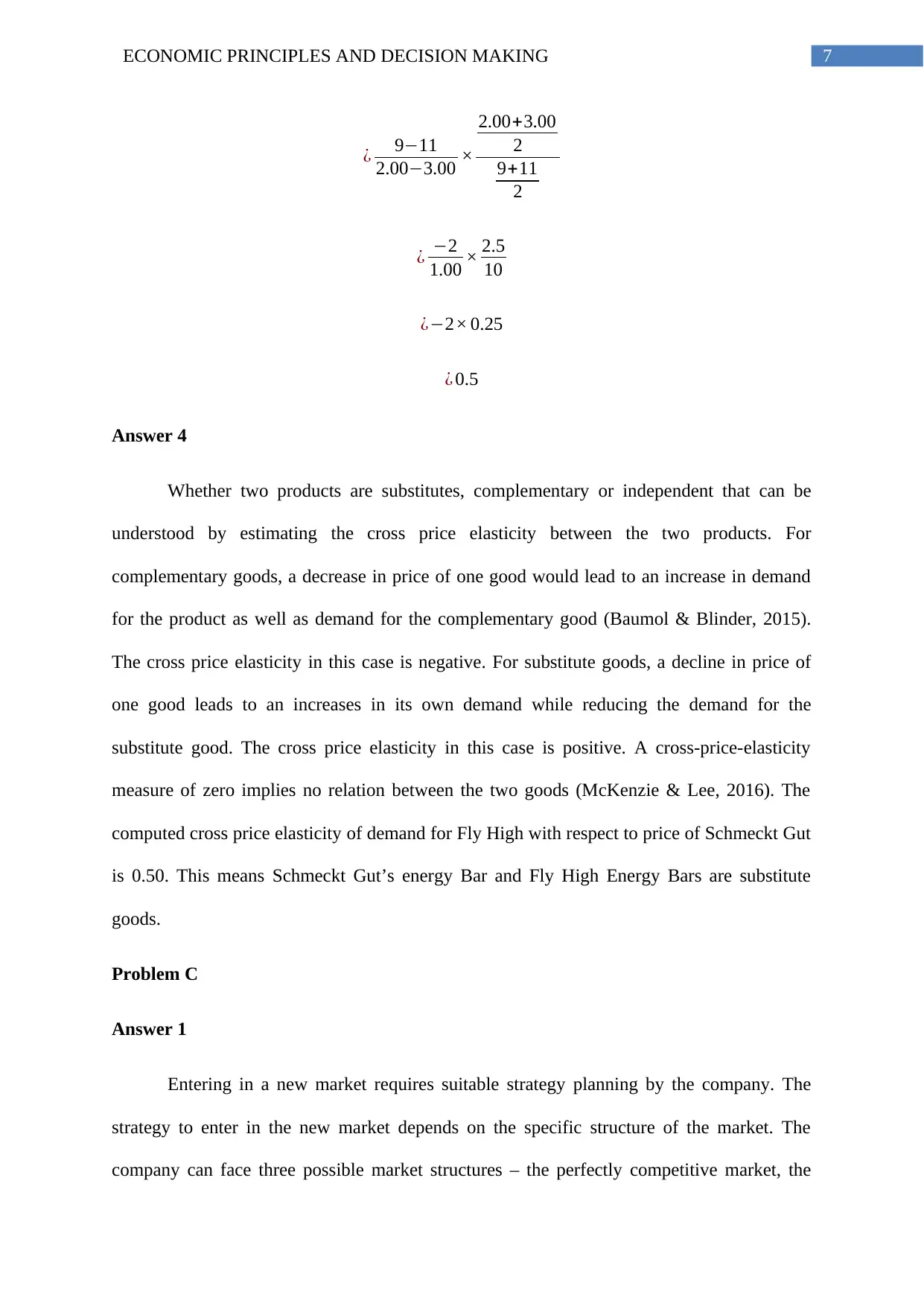
7ECONOMIC PRINCIPLES AND DECISION MAKING
¿ 9−11
2.00−3.00 ×
2.00+3.00
2
9+11
2
¿ −2
1.00 × 2.5
10
¿−2× 0.25
¿ 0.5
Answer 4
Whether two products are substitutes, complementary or independent that can be
understood by estimating the cross price elasticity between the two products. For
complementary goods, a decrease in price of one good would lead to an increase in demand
for the product as well as demand for the complementary good (Baumol & Blinder, 2015).
The cross price elasticity in this case is negative. For substitute goods, a decline in price of
one good leads to an increases in its own demand while reducing the demand for the
substitute good. The cross price elasticity in this case is positive. A cross-price-elasticity
measure of zero implies no relation between the two goods (McKenzie & Lee, 2016). The
computed cross price elasticity of demand for Fly High with respect to price of Schmeckt Gut
is 0.50. This means Schmeckt Gut’s energy Bar and Fly High Energy Bars are substitute
goods.
Problem C
Answer 1
Entering in a new market requires suitable strategy planning by the company. The
strategy to enter in the new market depends on the specific structure of the market. The
company can face three possible market structures – the perfectly competitive market, the
¿ 9−11
2.00−3.00 ×
2.00+3.00
2
9+11
2
¿ −2
1.00 × 2.5
10
¿−2× 0.25
¿ 0.5
Answer 4
Whether two products are substitutes, complementary or independent that can be
understood by estimating the cross price elasticity between the two products. For
complementary goods, a decrease in price of one good would lead to an increase in demand
for the product as well as demand for the complementary good (Baumol & Blinder, 2015).
The cross price elasticity in this case is negative. For substitute goods, a decline in price of
one good leads to an increases in its own demand while reducing the demand for the
substitute good. The cross price elasticity in this case is positive. A cross-price-elasticity
measure of zero implies no relation between the two goods (McKenzie & Lee, 2016). The
computed cross price elasticity of demand for Fly High with respect to price of Schmeckt Gut
is 0.50. This means Schmeckt Gut’s energy Bar and Fly High Energy Bars are substitute
goods.
Problem C
Answer 1
Entering in a new market requires suitable strategy planning by the company. The
strategy to enter in the new market depends on the specific structure of the market. The
company can face three possible market structures – the perfectly competitive market, the
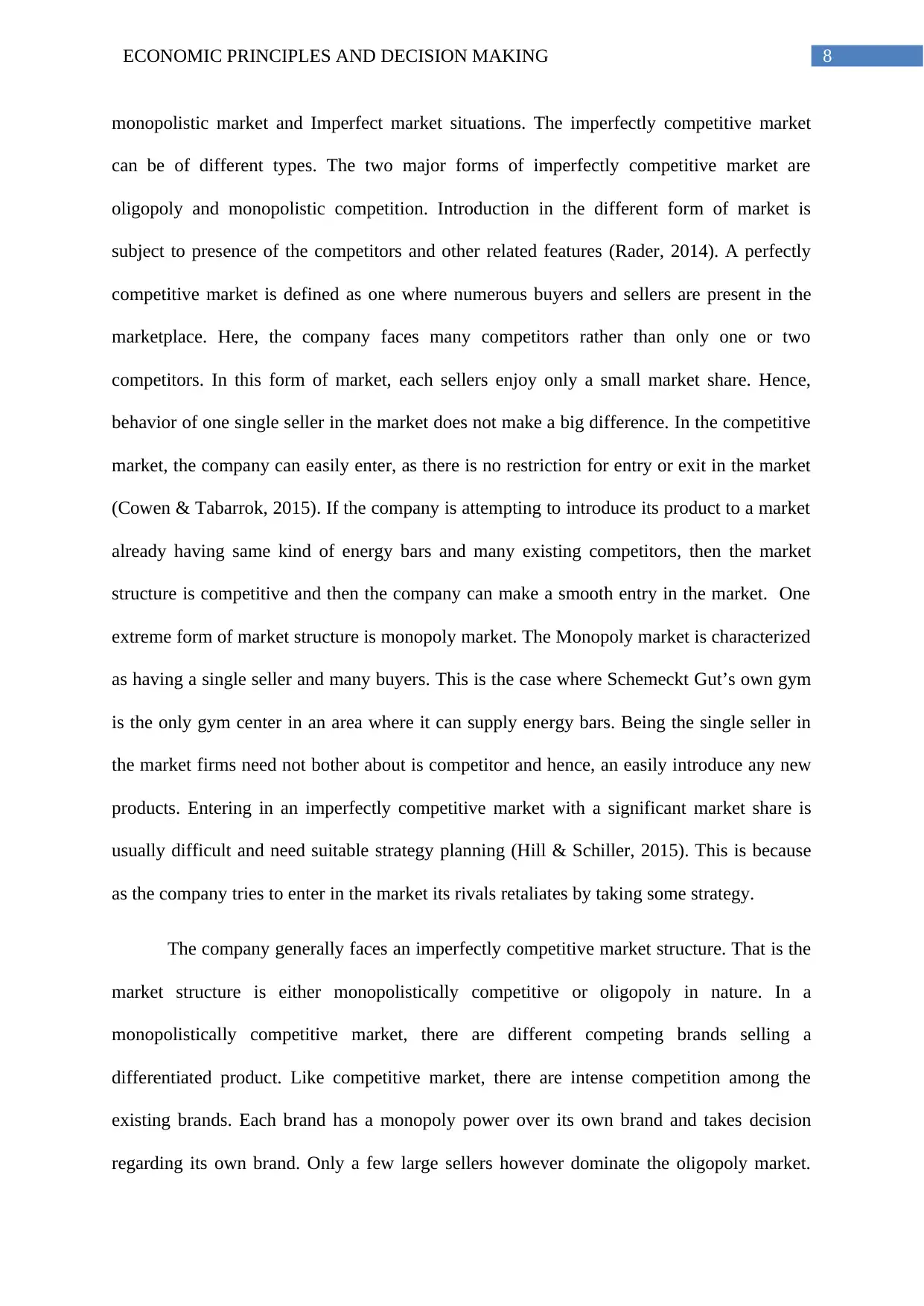
8ECONOMIC PRINCIPLES AND DECISION MAKING
monopolistic market and Imperfect market situations. The imperfectly competitive market
can be of different types. The two major forms of imperfectly competitive market are
oligopoly and monopolistic competition. Introduction in the different form of market is
subject to presence of the competitors and other related features (Rader, 2014). A perfectly
competitive market is defined as one where numerous buyers and sellers are present in the
marketplace. Here, the company faces many competitors rather than only one or two
competitors. In this form of market, each sellers enjoy only a small market share. Hence,
behavior of one single seller in the market does not make a big difference. In the competitive
market, the company can easily enter, as there is no restriction for entry or exit in the market
(Cowen & Tabarrok, 2015). If the company is attempting to introduce its product to a market
already having same kind of energy bars and many existing competitors, then the market
structure is competitive and then the company can make a smooth entry in the market. One
extreme form of market structure is monopoly market. The Monopoly market is characterized
as having a single seller and many buyers. This is the case where Schemeckt Gut’s own gym
is the only gym center in an area where it can supply energy bars. Being the single seller in
the market firms need not bother about is competitor and hence, an easily introduce any new
products. Entering in an imperfectly competitive market with a significant market share is
usually difficult and need suitable strategy planning (Hill & Schiller, 2015). This is because
as the company tries to enter in the market its rivals retaliates by taking some strategy.
The company generally faces an imperfectly competitive market structure. That is the
market structure is either monopolistically competitive or oligopoly in nature. In a
monopolistically competitive market, there are different competing brands selling a
differentiated product. Like competitive market, there are intense competition among the
existing brands. Each brand has a monopoly power over its own brand and takes decision
regarding its own brand. Only a few large sellers however dominate the oligopoly market.
monopolistic market and Imperfect market situations. The imperfectly competitive market
can be of different types. The two major forms of imperfectly competitive market are
oligopoly and monopolistic competition. Introduction in the different form of market is
subject to presence of the competitors and other related features (Rader, 2014). A perfectly
competitive market is defined as one where numerous buyers and sellers are present in the
marketplace. Here, the company faces many competitors rather than only one or two
competitors. In this form of market, each sellers enjoy only a small market share. Hence,
behavior of one single seller in the market does not make a big difference. In the competitive
market, the company can easily enter, as there is no restriction for entry or exit in the market
(Cowen & Tabarrok, 2015). If the company is attempting to introduce its product to a market
already having same kind of energy bars and many existing competitors, then the market
structure is competitive and then the company can make a smooth entry in the market. One
extreme form of market structure is monopoly market. The Monopoly market is characterized
as having a single seller and many buyers. This is the case where Schemeckt Gut’s own gym
is the only gym center in an area where it can supply energy bars. Being the single seller in
the market firms need not bother about is competitor and hence, an easily introduce any new
products. Entering in an imperfectly competitive market with a significant market share is
usually difficult and need suitable strategy planning (Hill & Schiller, 2015). This is because
as the company tries to enter in the market its rivals retaliates by taking some strategy.
The company generally faces an imperfectly competitive market structure. That is the
market structure is either monopolistically competitive or oligopoly in nature. In a
monopolistically competitive market, there are different competing brands selling a
differentiated product. Like competitive market, there are intense competition among the
existing brands. Each brand has a monopoly power over its own brand and takes decision
regarding its own brand. Only a few large sellers however dominate the oligopoly market.
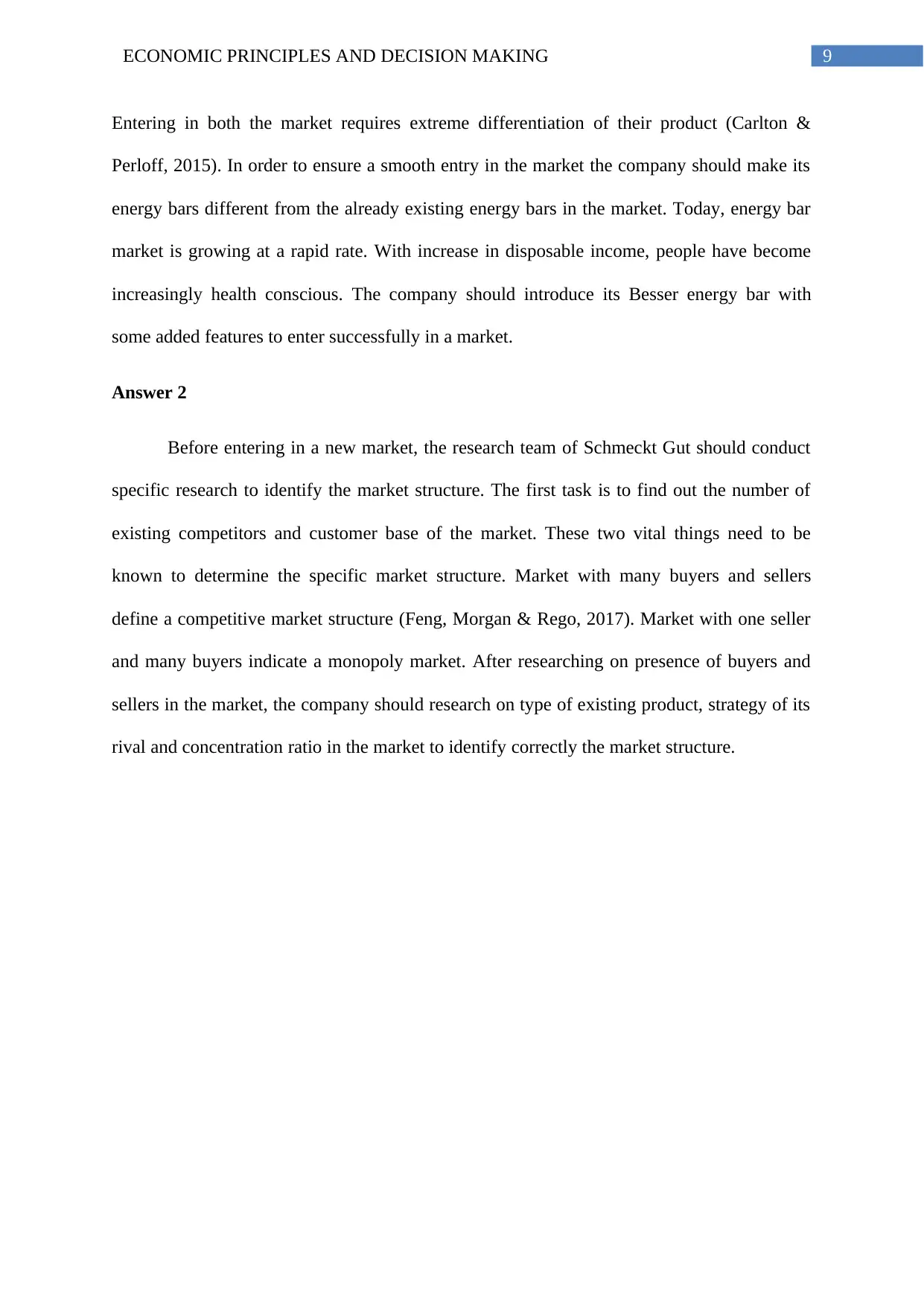
9ECONOMIC PRINCIPLES AND DECISION MAKING
Entering in both the market requires extreme differentiation of their product (Carlton &
Perloff, 2015). In order to ensure a smooth entry in the market the company should make its
energy bars different from the already existing energy bars in the market. Today, energy bar
market is growing at a rapid rate. With increase in disposable income, people have become
increasingly health conscious. The company should introduce its Besser energy bar with
some added features to enter successfully in a market.
Answer 2
Before entering in a new market, the research team of Schmeckt Gut should conduct
specific research to identify the market structure. The first task is to find out the number of
existing competitors and customer base of the market. These two vital things need to be
known to determine the specific market structure. Market with many buyers and sellers
define a competitive market structure (Feng, Morgan & Rego, 2017). Market with one seller
and many buyers indicate a monopoly market. After researching on presence of buyers and
sellers in the market, the company should research on type of existing product, strategy of its
rival and concentration ratio in the market to identify correctly the market structure.
Entering in both the market requires extreme differentiation of their product (Carlton &
Perloff, 2015). In order to ensure a smooth entry in the market the company should make its
energy bars different from the already existing energy bars in the market. Today, energy bar
market is growing at a rapid rate. With increase in disposable income, people have become
increasingly health conscious. The company should introduce its Besser energy bar with
some added features to enter successfully in a market.
Answer 2
Before entering in a new market, the research team of Schmeckt Gut should conduct
specific research to identify the market structure. The first task is to find out the number of
existing competitors and customer base of the market. These two vital things need to be
known to determine the specific market structure. Market with many buyers and sellers
define a competitive market structure (Feng, Morgan & Rego, 2017). Market with one seller
and many buyers indicate a monopoly market. After researching on presence of buyers and
sellers in the market, the company should research on type of existing product, strategy of its
rival and concentration ratio in the market to identify correctly the market structure.
Secure Best Marks with AI Grader
Need help grading? Try our AI Grader for instant feedback on your assignments.
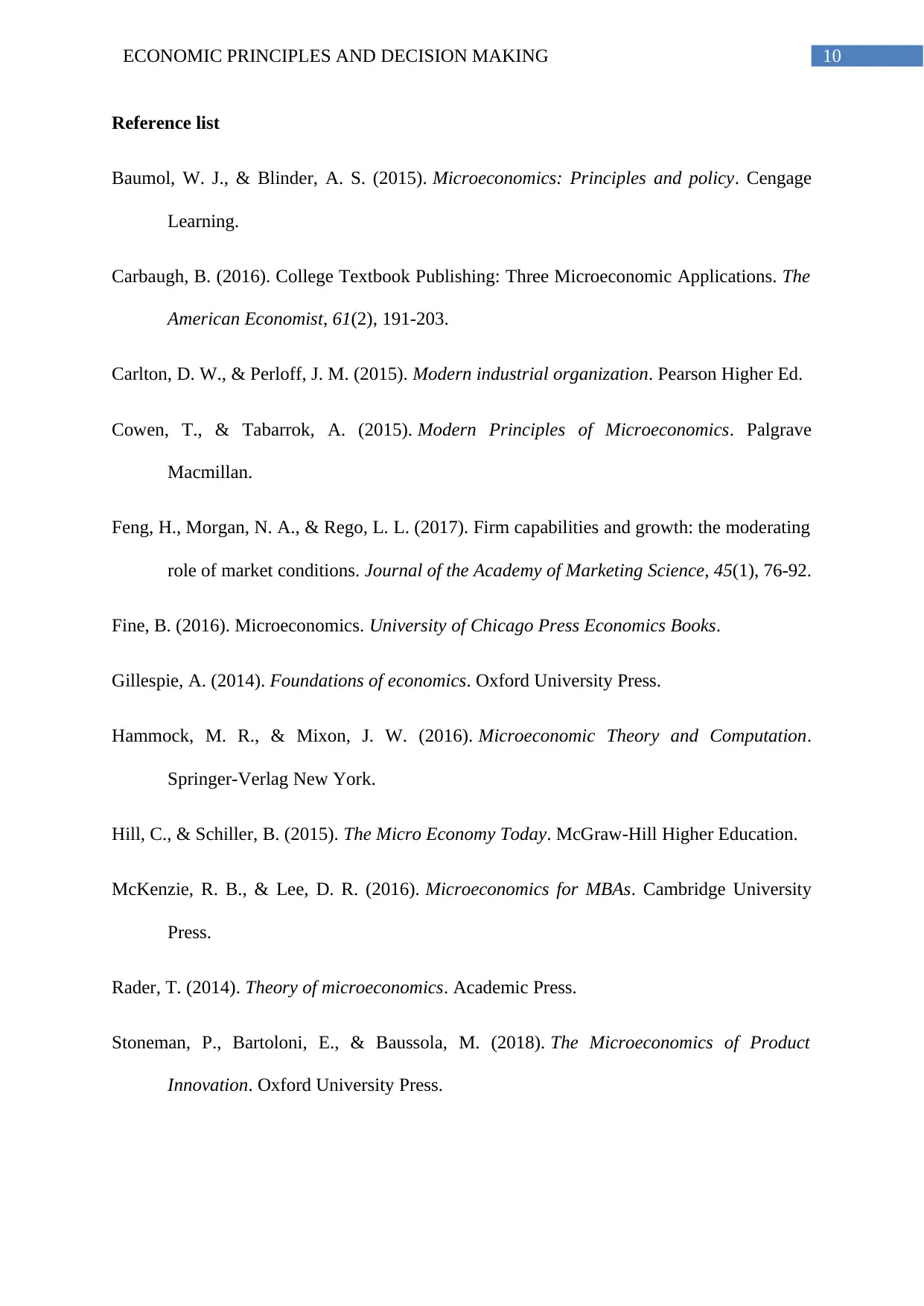
10ECONOMIC PRINCIPLES AND DECISION MAKING
Reference list
Baumol, W. J., & Blinder, A. S. (2015). Microeconomics: Principles and policy. Cengage
Learning.
Carbaugh, B. (2016). College Textbook Publishing: Three Microeconomic Applications. The
American Economist, 61(2), 191-203.
Carlton, D. W., & Perloff, J. M. (2015). Modern industrial organization. Pearson Higher Ed.
Cowen, T., & Tabarrok, A. (2015). Modern Principles of Microeconomics. Palgrave
Macmillan.
Feng, H., Morgan, N. A., & Rego, L. L. (2017). Firm capabilities and growth: the moderating
role of market conditions. Journal of the Academy of Marketing Science, 45(1), 76-92.
Fine, B. (2016). Microeconomics. University of Chicago Press Economics Books.
Gillespie, A. (2014). Foundations of economics. Oxford University Press.
Hammock, M. R., & Mixon, J. W. (2016). Microeconomic Theory and Computation.
Springer-Verlag New York.
Hill, C., & Schiller, B. (2015). The Micro Economy Today. McGraw-Hill Higher Education.
McKenzie, R. B., & Lee, D. R. (2016). Microeconomics for MBAs. Cambridge University
Press.
Rader, T. (2014). Theory of microeconomics. Academic Press.
Stoneman, P., Bartoloni, E., & Baussola, M. (2018). The Microeconomics of Product
Innovation. Oxford University Press.
Reference list
Baumol, W. J., & Blinder, A. S. (2015). Microeconomics: Principles and policy. Cengage
Learning.
Carbaugh, B. (2016). College Textbook Publishing: Three Microeconomic Applications. The
American Economist, 61(2), 191-203.
Carlton, D. W., & Perloff, J. M. (2015). Modern industrial organization. Pearson Higher Ed.
Cowen, T., & Tabarrok, A. (2015). Modern Principles of Microeconomics. Palgrave
Macmillan.
Feng, H., Morgan, N. A., & Rego, L. L. (2017). Firm capabilities and growth: the moderating
role of market conditions. Journal of the Academy of Marketing Science, 45(1), 76-92.
Fine, B. (2016). Microeconomics. University of Chicago Press Economics Books.
Gillespie, A. (2014). Foundations of economics. Oxford University Press.
Hammock, M. R., & Mixon, J. W. (2016). Microeconomic Theory and Computation.
Springer-Verlag New York.
Hill, C., & Schiller, B. (2015). The Micro Economy Today. McGraw-Hill Higher Education.
McKenzie, R. B., & Lee, D. R. (2016). Microeconomics for MBAs. Cambridge University
Press.
Rader, T. (2014). Theory of microeconomics. Academic Press.
Stoneman, P., Bartoloni, E., & Baussola, M. (2018). The Microeconomics of Product
Innovation. Oxford University Press.
1 out of 11
Related Documents
Your All-in-One AI-Powered Toolkit for Academic Success.
+13062052269
info@desklib.com
Available 24*7 on WhatsApp / Email
![[object Object]](/_next/static/media/star-bottom.7253800d.svg)
Unlock your academic potential
© 2024 | Zucol Services PVT LTD | All rights reserved.




